The Most Powerful Armlock in Judo:
Jujigatame -- The Cross Armlock
By Neil Ohlenkamp
Editor’s Note: For all those martial artists who
are not judo practitioners, but who understand the importance of cross
training, this is an important technique. If you ever find yourself on
the ground with a grappler, even if you don’t apply this technique
yourself, you should understand the how, where and when of this technique,
as others might try to exercise this armlock on you. Thus, understanding
the cross armlock is a basic form of self-defense.
The Kodokan Judo technique Ude Hishigi Juji Gatame is commonly called
jujigatame, or cross armlock. It gets its name from the position of the
person doing the technique (tori) across the opponent's body. It is one
of the most effective armlocks in judo, and it is consistently the number
one winning armlock used in international judo competition. It is equally
effective when used for self-defense, and the technique is included in
many modern and traditional jujutsu systems. It is particularly powerful
because tori uses the entire body, including the strength of the legs
and hips, to control the person receiving the technique (uke) and to
apply tremendous pressure to the straightened arm. For this reason it
can be done against much larger or stronger opponents without difficulty.
For the same reason it is also potentially dangerous and should only
be practiced with proper safety precautions and instruction.
There are many variations of jujigatame done from different positions
and angles, and numerous entries to the armlock from various opportunities.
These include variations done from the back when uke is approaching from
between the legs, turnovers from the hands and knees position, and the
flying jujigatame done from the standing position. The basic version
shown below was included in the kata of Kodokan Judo grappling techniques
(katame-no-kata) by the founder of judo, Jigoro Kano. It is shown below
by Neil Ohlenkamp, rokudan, on Jerrod Wilson, sankyu.
1. Beginning in the most common position gained after completing a successful
throw (sweep, or a strike in karate, taekwondo or kung fu), tori drops
his right knee onto uke to begin controlling him and to prevent him from
turning towards tori. The left knee can also be used for this purpose
on the head. Both hands control uke's arm with one forearm placed on
uke's elbow.
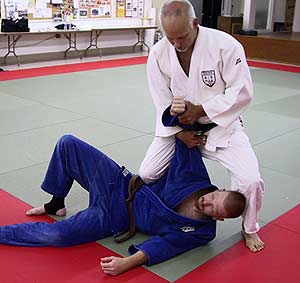
2. Tori begins to get better control of uke's arm by squatting, and
pulling uke's elbow tightly onto tori's stomach or chest. Tori also places
his left foot over uke's head so that uke will not be able to sit up.
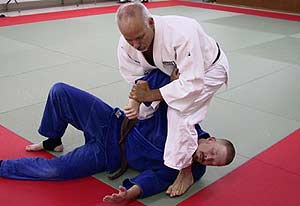
3. Tori sits down very close to uke's shoulder so that uke's arm is
still controlled by tori's body. Uke's elbow must be on tori's abdomen
in the final position, so sitting close under the elbow is essential.
Tori pulls uke's elbow strongly with his right forearm.
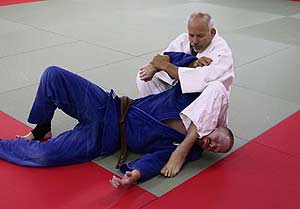
4. Tori begins to lean back keeping constant pressure on uke's arm and
squeezing the knees together to control the shoulder. Using the legs,
tori should be able to keep uke down even without applying the joint-lock
pressure. At this point tori makes sure that uke's thumb is pointing
up so that the pressure will be applied towards the little finger side
of the arm.
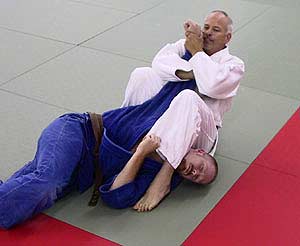
5. In the final position uke taps to submit from the pain in the elbow
joint. The submission should come immediately when the arm is fully extended.
For additional pressure tori can lift his hips by bridging, but this
must be done slowly and carefully because it may result in dislocating
the elbow.
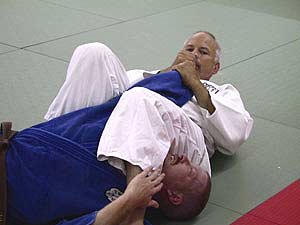
6. Tori's hand position can vary from the standard position with both
hands grabbing uke's wrist. In this version tori has his arms crossed
with the forearms controlling uke's wrist. This is useful when uke is
fighting the arm extension and tori needs to use the power of his body
to pull.
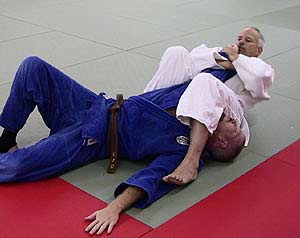
7. Another common version of this technique is done with both legs placed
over uke to further limit his ability to roll up onto tori.
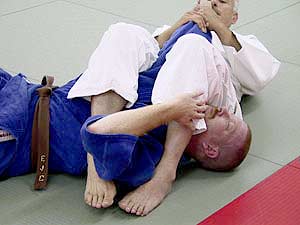
8. A strong variation is to cross the right foot over the left and to
pull in with the feet. This will help to control uke's left arm, and
to prevent uke from pushing tori's left leg off his head in an escape
attempt.
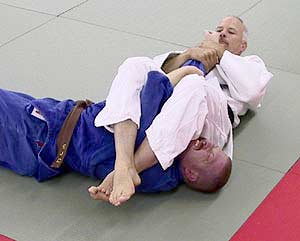
There are many opportunities for applying this armbar while grappling,
but the key is always to control the opponent's body, and particularly
the elbow, throughout the application of jujigatame.
About the Author:
Neil Ohlenkamp is a martial arts teacher and founder of the internationally
acclaimed judo website: www.judoinfo.com. He holds a seventh degree
black belt in Judo and a sixth degree black belt in jujitsu and
has over 31 years of training and experience in various martial
arts as a competitor, instructor, team coach, and tournament official.
He is a certified United States Judo Association instructor, referee,
master rank examiner, and master coach (the highest level of certification),
and he was awarded United States Judo Coach of the Year for 1999.
Ohlenkamp is an advisor to FightingArts.com and has been a regular
contributor of articles on judo and related topics.
|